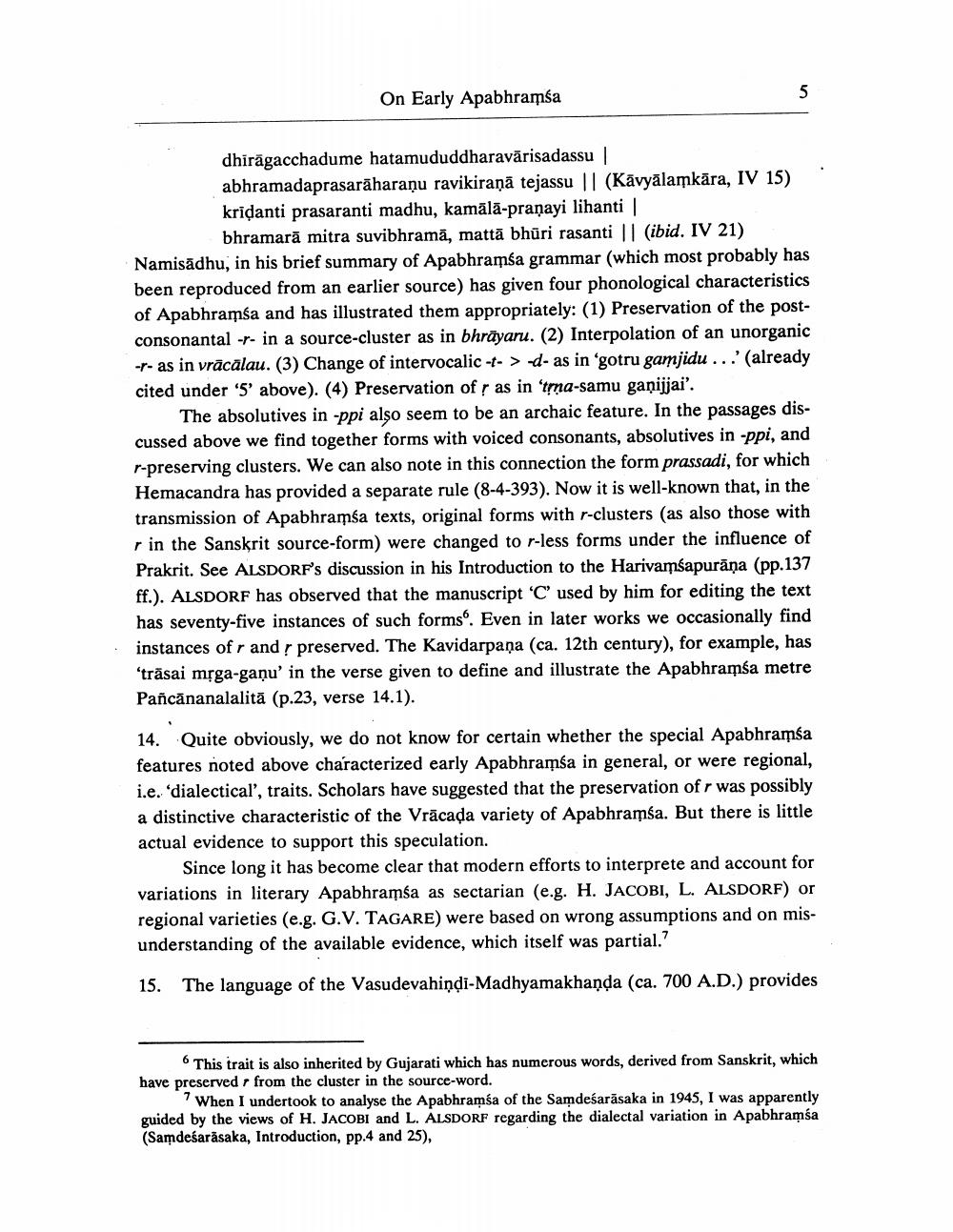Book Title: On Early Apbhramsa Author(s): H C Bhayani Publisher: H C Bhayani View full book textPage 5
________________ On Early Apabhramsa 5 dhiragacchadume hatamududdharavärisadassu | abhramadaprasaräharanu ravikirana tejassu || (Kävyälamkāra, IV 15) kridanti prasaranti madhu, kamälä-pranayi lihanti | bhramarā mitra suvibhrama, mattā bhūri rasanti || (ibid. IV 21) Namisadhu, in his brief summary of Apabhramsa grammar (which most probably has been reproduced from an earlier source) has given four phonological characteristics of Apabhramsa and has illustrated them appropriately: (1) Preservation of the postconsonantal in a source-cluster as in bhrayaru. (2) Interpolation of an unorganic -- as in vracalau. (3) Change of intervocalic-t->d- as in 'gotru gamjidu... (already cited under '5' above). (4) Preservation of r as in 'trna-samu ganijjai". The absolutives in -ppi also seem to be an archaic feature. In the passages discussed above we find together forms with voiced consonants, absolutives in -ppi, and r-preserving clusters. We can also note in this connection the form prassadi, for which Hemacandra has provided a separate rule (8-4-393). Now it is well-known that, in the transmission of Apabhramsa texts, original forms with r-clusters (as also those with r in the Sanskrit source-form) were changed to r-less forms under the influence of Prakrit. See ALSDORF's discussion in his Introduction to the Harivamsapurana (pp.137 ff.). ALSDORF has observed that the manuscript 'C' used by him for editing the text has seventy-five instances of such forms". Even in later works we occasionally find instances of r and r preserved. The Kavidarpana (ca. 12th century), for example, has 'trāsai mṛga-ganu' in the verse given to define and illustrate the Apabhramsa metre Pañcananalalită (p.23, verse 14.1). 14. Quite obviously, we do not know for certain whether the special Apabhramsa features noted above characterized early Apabhramsa in general, or were regional, i.e. 'dialectical', traits. Scholars have suggested that the preservation of r was possibly a distinctive characteristic of the Vracada variety of Apabhramsa. But there is little actual evidence to support this speculation. Since long it has become clear that modern efforts to interprete and account for variations in literary Apabhramsa as sectarian (e.g. H. JACOBI, L. ALSDORF) or regional varieties (e.g. G.V. TAGARE) were based on wrong assumptions and on misunderstanding of the available evidence, which itself was partial." The language of the Vasudevahindi-Madhyamakhanda (ca. 700 A.D.) provides 6 This trait is also inherited by Gujarati which has numerous words, derived from Sanskrit, which have preserved from the cluster in the source-word. When I undertook to analyse the Apabhramsa of the Samdeśarāsaka in 1945, I was apparently guided by the views of H. JACOBI and L. ALSDORF regarding the dialectal variation in Apabhramsa (Samdeśarāsaka, Introduction, pp.4 and 25),Page Navigation
1 ... 3 4 5 6 7
